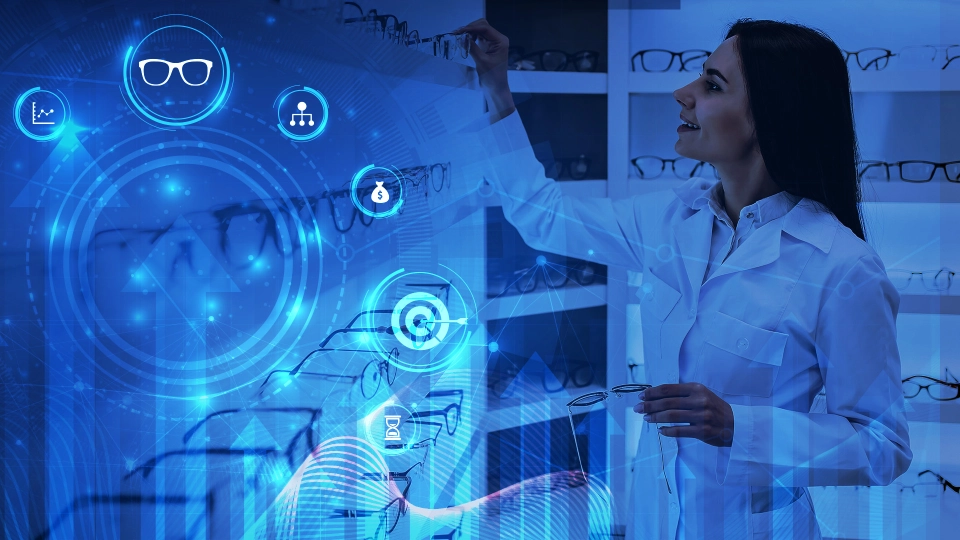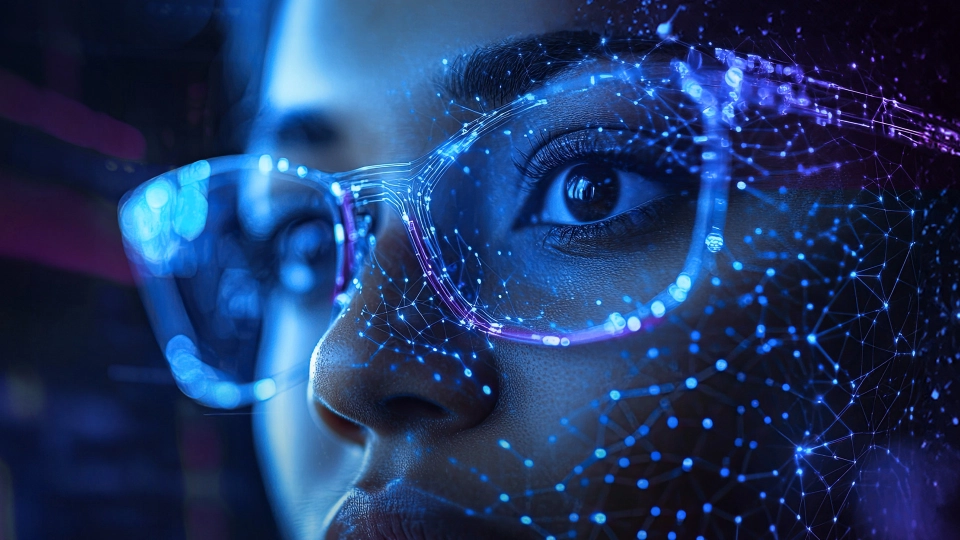
AI-Powered Lenses Are Here: What This Means for Labs, ECPs, and Patients
- What are AI lenses?
- How do AI lenses work?
- How AI transforms lens personalization
- Why AI is the future for optical labs and ECPs
- 1. Better decision-making for ECPs
- 2. AI progressive lenses reducing adaptation issues
- 3. Enhanced efficiencies for labs
- 4. Competitive differentiation
- The benefits of Endless AI
- 1. Real-time lens optimization
- 2. Improved patient confidence
- 3. Material and coating optimization
- 4. Second pair recommendations

AI-Powered Lenses Are Here: What This Means for Labs, ECPs, and Patients
The use of artificial intelligence is growing across industries, advancing reasoning, tech, and design globally, and the ophthalmology industry is no different. AI helps change how lenses are designed, manufactured, and prescribed. For labs and eye care professionals (ECPs), AI-driven lens innovation leads to remarkable personalization, precision, manufacturing efficiency, and improved patient outcomes. It’s key for optical chains, online retailers, and ECPs to understand how AI helps optimize operations and reveal patterns that lead to better prescribed eyecare solutions. Endless AI by IOT, for example, leans into this trend by using AI that integrates ideal lens features with key factors like lifestyle, expectations, preferences, and satisfaction data from previous wearers, to create a solution uniquely tailored for each wearer.
What are AI lenses?
AI lenses are ophthalmic lenses created or refined using artificial intelligence. These lenses are single-vision, progressive, or specialized designs. Unlike traditional lenses that rely on standardized designs and limited customization options, AI-powered lenses use complex algorithms to analyze multiple data points about each wearer to generate a hyper-personalized design for the wearer’s visual demands.
AI goes beyond traditional parameters (sphere, cylinder, and axis) to assess a patient’s vision. The AI additionally factors in a patient’s occupation, daily activities, environment, and usage patterns to choose a lens design that offers better personalization, faster adaptation, sharpness, and comfort.
How do AI lenses work?

AI systems analyze large datasets about wearer profiles, prescriptions, lifestyle information, and visual issues. These datasets often contain hundreds of thousands of profiles, filled with data that AI quickly parses into patterns and insights. AI compares the new patient’s profile with similar profiles in the dataset to determine which lenses had the highest satisfaction. Through continuous learning, the algorithms become skilled at identifying which lens features work best for each specific scenario.
At the core, AI lens technology works in a few easy steps:
- Data collection: Gathering comprehensive information about the wearer through advanced diagnostic tools and questionnaires
- Pattern recognition: Identifying correlations between visual needs and optimal lens designs
- Predictive modeling: Forecasting the most suitable lens configurations based on similar profiles
- Continuous learning: Refining recommendations through feedback and outcomes
How AI transforms lens personalization
AI can hyper-personalize lenses for patients to a specificity not yet seen. A decade ago, progressive lenses were considered advanced if they could effectively minimize distortions through a conventional corridor. Today, AI-driven design interprets massive datasets and user feedback to propose micro-recommendations for corridor length, lens curvature, or recommended coatings that match a wearer’s lifestyle and visual habits.
Using AI allows lens designers to incorporate more layers of information, such as occupational and recreational needs. Some personalization factors AI systems are adept at assessing are:
- Occupational needs: Optimizing intermediate zones for computer users or enhancing distance clarity for drivers
- Recreational activities: Tailoring lens performance for specific hobbies or sports
- Environmental factors: Adjusting designs for different lighting conditions or geographical locations
- Wearing history: Accounting for previous lens experiences and preferences
AI makes good use of these factors by evaluating thousands of possible lens combinations in real-time, identifying optimal features based on a patient’s biometrics and profile compared to similar profiles in the dataset. This enables a level of specificity that would be impossible through manual calculation alone. It also goes a step beyond relying on theoretical optical models and incorporates real-world wearing experiences.
Why AI is the future for optical labs and ECPs
AI is reshaping the workflows of optical labs, manufacturers, and ECP practices by improving operations with measures like real-time data analytics and automated lens processing equipment. It streamlines production by offering predictive maintenance for machinery, ensuring quality control, and providing advanced patient care. Some of the most popular reasons AI is taking a stronghold in the ophthalmic industry are:
1. Better decision-making for ECPs
AI-powered data modeling reduces guesswork. The system suggests an evidence-based lens configuration that is more accurate from the outset, improving wearer satisfaction and saving valuable time for both patient and practitioner. ECPs can also have more confidence when prescribing lenses due to the data-backed validation confirmed by AI. These personalized solutions can lead to less trial and error, meaning greater patient happiness.
2. AI progressive lenses reducing adaptation issues
One of the most significant challenges in prescribing progressive lenses has always been adaptation difficulties. AI systems help address this by:
- Predicting potential adaptation issues before they occur
- Recommending designs that match individual adaptation capabilities
- Suggesting optimal frame selection to complement lens design
- Adjusting parameters to minimize peripheral distortion based on individual sensitivity
The result is a progressive lens that feels more intuitive, adapting to a patient’s gaze and posture more naturally than traditionally designed progressive lenses.
3. Enhanced efficiencies for labs
For optical labs, one of AI’s most compelling advantages is efficiency. By analyzing every job order in real time, AI can make recommendations on manufacturing parameters that optimize both material usage and production speed. Labs can route complex prescriptions to equipment best suited for the job, predict lens breakage or coating failures, and even optimize inventory levels.
More accurate predictions of wearer satisfaction mean fewer returns and adjustments. The advanced pattern recognition of AI can also detect subtle defects that might otherwise be missed. These operational enhancements can translate into significant cost savings over time.
4. Competitive differentiation
Only a few companies have intentionally introduced AI into their daily practices. In a competitive market, this allows labs and ECPs to offer a unique value proposition and brand differentiation. Offering an advanced technology also justifies premium price points. Even once AI becomes ubiquitous throughout the industry, there is value in being an early adopter and remaining steps ahead of the competition by understanding AI’s practical use.
The benefits of Endless AI

Endless AI is a lens design powered by IOT Artificial Intelligence technology to create hyper-personalized lenses. Endless AI considers many factors beyond prescription details, such as lifestyle habits, reading distances, environmental variables, and personal preferences. Traditional lens design approaches might rely on sporadic or limited feedback from controlled clinical studies. Endless AI, by contrast, collects real-world input from large swaths of wearers to create a progressive, anti-fatigue, or single-vision prescription. Once the AI platform recommends a lens, the system continues to learn and refine its data model based on wearer feedback and performance data.
As a result, every subsequent patient benefits from the experiences of all who came before them, creating an ever-evolving ecosystem of lens intelligence. The continuous learning function allows AI to adapt designs more quickly and accurately, discovering new relationships between lens features and user experiences that might otherwise remain hidden.
Endless AI provides additional benefits like:
1. Real-time lens optimization
Endless AI evaluates thousands of possible lens combinations instantaneously, identifying optimal features for each wearer base. This capability transforms the lens selection process from educated guesswork to precision engineering. AI removes much of the subjectivity that comes with human decision-making, letting data drive the lens selection process.
2. Improved patient confidence
Patients often report higher satisfaction levels with a more precise lens from the outset, reducing the need for multiple follow-up visits or lens remakes. In a study of over 5,000 progressive lens wearers, 96% were satisfied with their Endless AI lenses, with 86% reporting very high satisfaction. Even among groups that typically struggle with progressives, results were strong: first-time progressive wearers reported an adaptation satisfaction of 4.19/5, and myopic wearers rated near-vision satisfaction at 4.22/5. These results significantly outperform traditional lenses and help build lasting patient trust.
3. Material and coating optimization
While lens design is critical, materials and coatings can be a determining factor for a patient’s visual experience. Endless AI suggests lens finishes—anti-reflective coatings, UV protection, and anti-scratch—that align with how patients use their lenses daily.
4. Second pair recommendations
By analyzing each wearer’s environment and habits, Endless AI can suggest personalized second pairs of lenses, such as dedicated computer glasses, polarized lenses, or even photochromics. These complement a wearer’s primary eyewear, solving for the additional concern from the outset instead of waiting for a patient to return to the ECP and request additional visual help later.
The emergence of AI-powered lenses signals a significant shift in the ophthalmic industry. With tools like IOT’s Endless AI leading the charge, it’s clear that personalization and data-driven insights will become the standard rather than the exception. For optical labs, ECPs, and retailers—whether large chains or online platforms—adopting AI-driven technology can yield tangible benefits in patient satisfaction, operational efficiencies, and professional credibility.
Labs that embrace AI will likely set themselves apart as innovators, capable of delivering cutting-edge solutions faster and more precisely. Meanwhile, ECPs can elevate their practice by offering hyper-personalized lens options, deepening patient trust, and improving outcomes.
AI-powered lenses transform how vision correction is conceived, designed, and delivered. As the technology progresses, we can expect to see more innovation in diagnosing and correcting visual needs.
If you’re interested in learning more about how AI-powered lens designs can improve your practice or lab, please get in touch.
You may also like:
What Are Progressive Lenses & How Do They Work?
The Complete Guide to Bifocal Lenses
Guide to Optical Lenses: The Science Behind How They Work
.png)





